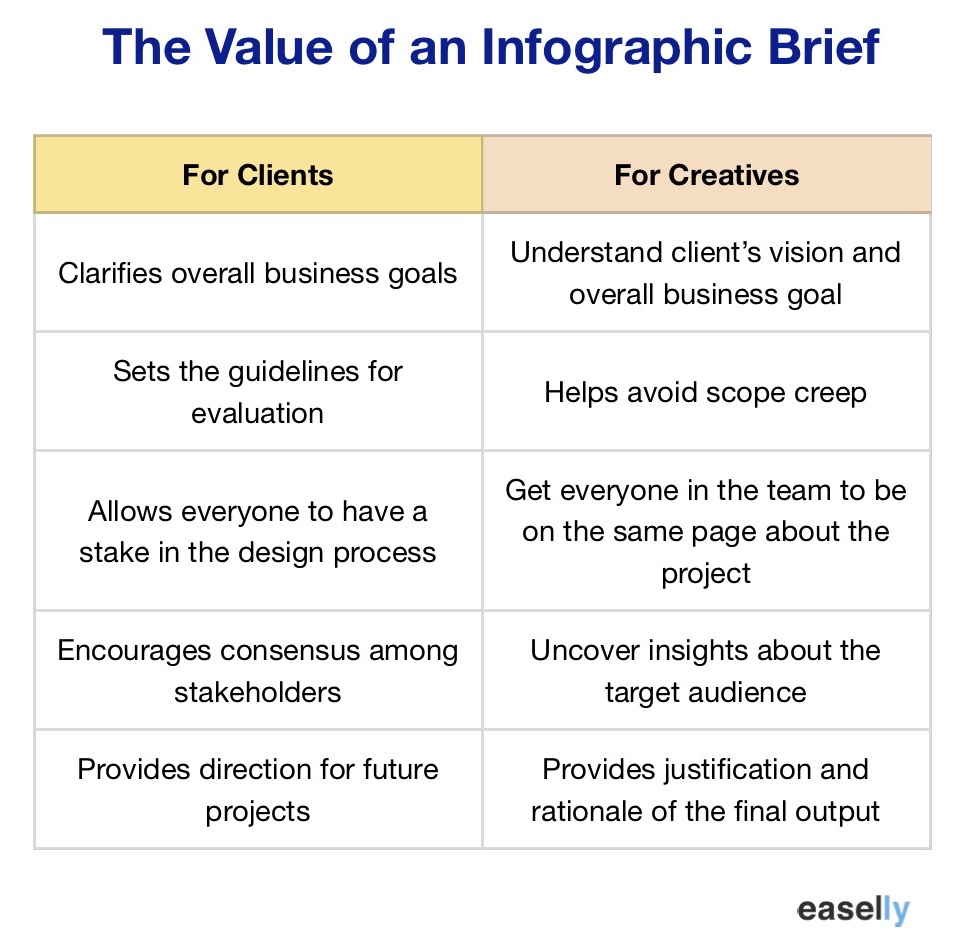You’ve probably stumbled upon infographics that undoubtedly nailed it in terms of engagement and shareability. Creatives and marketers call these pieces as content home runs.
So how do you come up with infographics that will dramatically increase your chances of hitting the proverbial content home run?
The truth is these popular infographics didn’t happen by accident. For every well-designed infographic, there’s almost always a thoughtful, creative brief behind it.
Before we begin, it’s worth noting that infographic briefs aren’t only critical for marketing campaigns.
Anyone who’s looking into creating infographics, whether for school or business, should consider writing an infographic brief!
The Value of a Compelling Brief in Infographic Design

What’s the use of infographic briefs when you’re a one-man team? Creative briefs are for large teams, right? Not really.
A good infographic brief clearly articulates what you want, how you want it, and when you want it.
An infographic design brief is more than just a piece of document. Whether you’re a one-man team or a large brand with distributed teams across the world, the creative brief is the cornerstone of every infographic project you’re about to embark.
It sets the vision, clarifies objectives (what if you don’t need an infographic after all?), and determines the direction of your infographic project.
It’s what you and the design team can refer back to during infographic development to ensure that everyone involved is on the same page.
What to Include in an Infographic Design Brief
Every infographic project is different and may require additional information, but here are the basics of what to do when writing infographic briefs.
1. The Objective
Write about the goal that you intend to achieve with your infographic.
Guiding questions:
- What do you want this infographic to achieve?
- What do you want your audience to do after reading or scanning your infographic?
- What’s the title/headline of your infographic?
2. The Target Audience
Identify and narrow down your target audience in your infographic brief. A vague understanding (or being too general) of who you’re designing the infographic for is one of the common mistakes when creating infographic briefs.
Basic demographics such as age and gender don’t help at all. Dig deep into the psychographics of your audience. What do they love, hate, or even ignore?
Guiding questions:
- Who are these people that you want to reach out through your infographic?
- How well do you know your audience’s concerns, needs, and priorities?
- What biases or perceptions do your audience have that might make them receptive or resistant to your message?
3. The Big Idea
Spell out the primary message you want to communicate to your audience in a synopsis or bulleted summary. Explain what you want the audience will take away from your infographic.
Guiding questions:
- What information or data is relevant to the audience and the purpose of your infographic?
- If you have a limited amount of time to communicate to your audience, what would you say in the infographic?
4. The Content
Think and plan for your content first before thinking about the visual aspect of your infographic. Besides writing the synopsis or summary, think about the content’s running order or sequence. Divide them into sections when you can.
Guiding questions:
- What kind of content and medium is relevant to my audience
- Any brand guidelines to follow concerning writing style, the tone of voice, and vocabulary?
- Is your content accurate and from a reliable source? Are footnotes required?
5. The Visual Specs
Provide samples for visual inspiration or anything else that you think will guide the designer in crafting the look and feel of your infographic.
Guiding questions:
- What are the specs (orientation, length, etc.) of the infographic?
- What colors do you want the designer to use? Any colors that should be avoided?
- Would you like more or less white space, grids, leading lines, etc.?
- Do you have brand guidelines or requirements?
- Are there existing images or charts that you want to include or is the design team free to develop their own?
- Do you have design examples of what should be avoided?
Additional details to include in your next infographic brief:
- Footnotes and sourcing
- Budget range, rights, and timelines
- Delivery formats – PDF, PNG, JPG, etc
- Internal resources like sales reports, white papers, and product brochures
- Similar infographics that will help the design team understand the context and purpose of your infographic
Don’t Start an Infographic Project Without a Well-Written Brief
Don’t start an infographic project or marketing campaign without a well-written brief. Keep it short, on point, and useful.
It’s time for you to rethink how you’re starting your infographic projects. You don’t want to get in touch with your infographic designer at the eleventh hour or make last-minute reiterations by yourself just because you skipped the most important step— the infographic design brief.
Need a gentle nudge with an infographic design project that’s going nowhere?
One of our designers can create a custom infographic for you (we’d really appreciate a well-written creative brief!).
Alternatively, you can try our free infographic maker if you want to bring out the inner artist in you! Easelly’s library of infographic templates is a good starting point if you don’t have the time to make infographics from scratch.

